Hyperconverged infrastructure (HCI) is all the rage these days. But there are two primary means of achieving it that IT organizations need to consider. They can either acquire an HCI appliance or license software that turns existing servers or infrastructure acquired separately into an HCI appliance.
To facilitate that latter approach, Red Hat has made available a Red Hat Hyperconverged Infrastructure, which combines an instance of the Kernel-based virtual machine, Red Hat Gluster storage software, the Red Hat Enterprise Linux (RHEL) operating system, and Ansible IT automation software to create an open source HCI platform.
Irshad Raihan, senior principal product marketing manager for Red Hat Storage, says in addition to reducing the cost of combining compute and storage, Red Hat Hyperconverged Infrastructure enables IT organizations to deploy a HCI platform without getting locked into a specific hardware appliance. Much like traditional servers, Raihan says Red Hat is betting that most organizations will continue to prefer to acquire hardware independently from the software stack that gets deployed on it.
While HCI is gaining popularity because it makes it simpler to manage compute and storage, Raihan notes that HCI will be only one of several options most organizations will wind up embracing.
“HCI is only one of many,” says Raihan.
The advantage of working with Red Hat, says Raihan, is that the various implementations of Linux required to support all those models can be supported via one single vendor.
At this point, there’s no doubt that HCI platforms are here to stay. But the decision concerning how best to go about implementing HCI will vary widely by IT organization.



